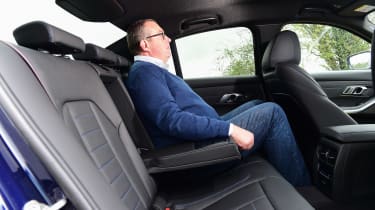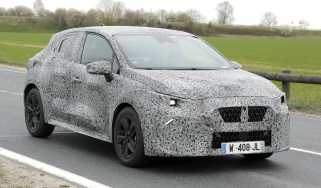BMW 3 Series - Practicality, comfort and boot space
Leg and head room are better than before, with the 3 Series now matching or beating its rivals for interior space

The 3 Series is bigger than it was before, and the main focus for BMW has been on improving accommodation for those in the back. As a result, it now offers a similar amount of space as the Audi A4 and the Mercedes C-Class. BMW says the 3 Series is now wide enough to accommodate three child seats side by side in the rear, but only the two outside positions come with Isofix points.
Both front seat occupants should be able to find a comfortable position with a good range of seat adjustment and a steering wheel that’s adjustable for height and rake. The standard upholstery included with the Sport trim is BMW’s ‘Sensatec’ upholstery, which is a vegan-friendly alternative to leather. Moving up to M Sport adds in part-Alcantara upholstery, along with the option of genuine leather.
Size
As with most new cars, the 3 Series has grown in comparison with its predecessor. It is now 4,709mm long (up by 85mm), 16mm wider (at 1,827mm) and a scant 1mm taller. The C-Class is a touch shorter by 23mm while the Audi A4 is longer at 4,738mm. The Audi is 13mm wider and the Mercedes is 17mm narrower – as near as makes no difference.
Used - available now

2022 BMW
3 Series
45,926 milesAutomaticPetrol2.0L
Cash £20,500
2020 BMW
3 Series
29,246 milesAutomaticDiesel2.0L
Cash £21,300
2022 BMW
3 Series
37,656 milesAutomaticPetrol3.0L
Cash £31,287
2022 BMW
3 Series
46,231 milesAutomaticPetrol2.0L
Cash £19,000What has changed significantly for the BMW 3 Series is that its wheelbase has been extended by 41mm, giving rear passengers more leg room. Indeed, it now has the longest wheelbase of the three cars. However, the Model 3 has a slightly longer wheelbase, helping to make it feel a little more roomy inside.
Leg room, head room and passenger space
If the 3 Series had previously been a little tight in the rear for three passengers, it now offers a decent amount of legroom. That’s thanks to the increase in wheelbase, but if three adults are carried in the rear, the middle seat passenger might feel a little hard done by as the middle seat base is firm and has little room for your feet thanks to the transmission tunnel – something that doesn’t exist in the Tesla Model 3 with its completely flat floor.
There should be no complaints on the amount of headroom though, because the 3 Series offers a few millimetres more than either the Audi A4 or Mercedes C-Class. There’s plenty of room for storing oddments too, with decently sized door pockets.
The driver and front seat passenger fare very well with comfortable and supportive seats. One slight disappointment is that lumbar support is an option rather than a standard feature, but this can be added for as a reasonably priced single extra, or as part of the Comfort Pack. Unfortunately, you will have to pay more for the pricey Comfort Plus Pack to get front-seat memory settings, a feature that comes as standard with the Model 3.
Boot
While the 3 Series has grown in size, the same cannot be said of its boot, which stays at 480 litres – the same as the previous generation model. It should be more than adequate for most buyers without being class-leading. The Audi A4 has an identically sized boot, but the C-Class falls a little short of its rivals with a 455-litre capacity. Then there is the Tesla Model 3, which not only has a large boot with a sizable underfloor storage area, but also a front boot big enough for another carry-on bag. Added together, it makes the Model 3 much more practical.
As standard, the 3 Series has 40:20:40 split folding rear seats that improve its practicality, along with some handy nets in the boot compartment to stop small items rolling around. An electrically operated boot lid is available as part of the Comfort Pack, allowing the lid to be opened by swiping your foot under the rear bumper.









